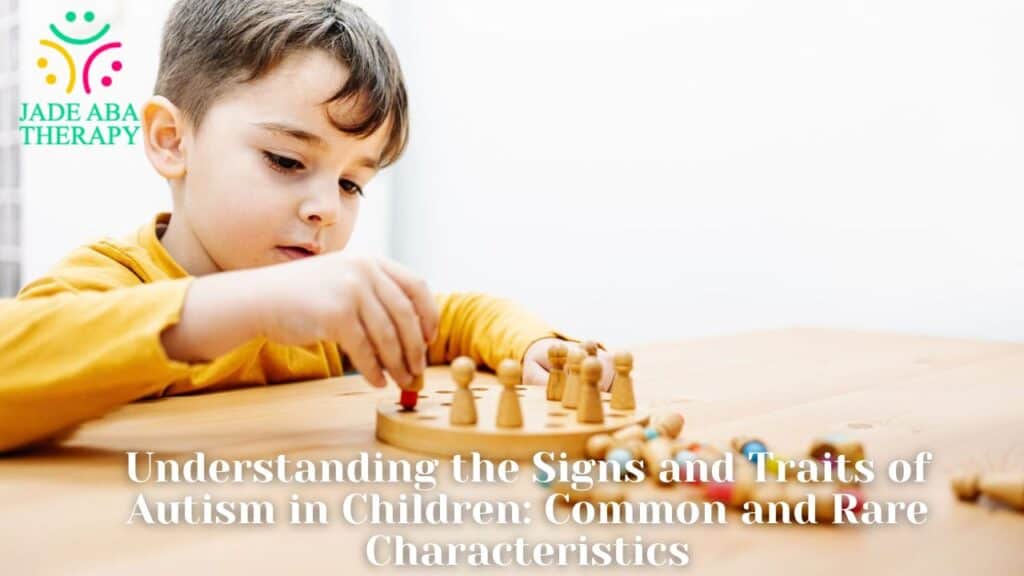Autism spectrum disorder (ASD) is a complex neurodevelopmental condition that affects communication, social skills, behavior, and sensory processing. The signs and symptoms of autism can vary widely from person to person, which is why ASD is called a “spectrum” disorder. While no two autistic individuals are exactly alike, there are common traits associated with ASD that can help identify it. Autism traits include social challenges, communication differences, repetitive behaviors, sensory sensitivities, narrow interests, difficulty with change, and atypical motor skills.
In this comprehensive guide, we will cover:
- The most common signs and traits of autism in young children
- More unusual or rare characteristics that may be seen
- Possible complications and co-existing conditions
- Differences in how autism presents in boys vs. girls
- When to see a healthcare provider about your concerns
- Answers to frequently asked questions about autism traits
Plus, a call to action for top-quality ABA therapy services that can make a life-changing difference for autistic children in Maryland.
Common Signs and Traits of Autism in Young Children
According to the National Institutes of Health (NIH), some of the most common signs of autism include:
Communication Difficulties
- No babbling or pointing by 12 months
- Not speaking single words by 16 months
- No two-word phrases by 24 months
- Loss of previously acquired language skills
- Odd or repetitive speech patterns
Lack of Social Engagement
- Not responding to their name being called
- Avoiding eye contact
- Not showing interest in peers or care givers
- Lack of facial expressions
- Failure to initiate interactions or share enjoyment
Repetitive and Restrictive Behaviors
- Repetitive body movements like rocking or hand flapping
- Obsessive attachment to unusual objects
- Excessive lining up or ordering of toys
- Adherence to rigid routines and rituals
- Narrow, intense interests
Sensory Differences
- Over- or under-reaction to sounds, textures, tastes, etc.
- Lack of response to pain or temperature
- Fascination with lights or spinning objects
- Seeking extreme sensory stimulation
While these traits tend to emerge before age 3, sometimes milder forms of ASD are not diagnosed until later childhood when social and behavioral challenges become more apparent. Some signs in older children include:
- Limited friendships with peers
- Lack of pretend or imaginative play
- Unusual speech patterns or monotone voice
- Difficulty relating to others socially
- Difficulty with changes in routine
- Clumsiness or awkward motor skills
So while autistic traits usually appear in early development, the exact presentation can vary greatly based on the child. Girls with ASD in particular tend to exhibit more subtle characteristics that are often overlooked.
More Unusual or Rare Traits of Autism
In addition to the common symptoms listed above, some autistic individuals may display more unusual characteristics like:
- Savant abilities – Extraordinary talent in one area, like math, music, art or memory
- Hyperlexia – Early ability to decode words without comprehension
- Synesthesia – Mixing up senses, like “hearing” colors
- Seizures – About 25% of autistic children develop epilepsy
- Intellectual disability – About 31% have an IQ under 70
- Gastrointestinal issues – Constipation, diarrhea, abdominal pain
- Sleep disturbances – Difficulty falling or staying asleep
- Motor skill challenges – Low muscle tone, clumsiness, poor handwriting
These traits are not necessarily required for an autism diagnosis, but they can co-occur. Autism is truly a spectrum, with each child exhibiting a unique combination of strengths and challenges. Paying attention to all developmental differences can help identify ASD earlier.
How Autism May Present Differently in Girls vs. Boys
One complicating factor in recognizing autism is that it often looks different in girls than boys. Estimates suggest that up to 4 times as many boys are diagnosed with ASD compared to girls.
There are a few possible reasons for this:
- More obvious symptoms – Autistic boys tend to have more externalizing behaviors like emotional outbursts, impulsivity, and hyperactivity. This draws more attention.
- Quieter presentation – Girls are more likely to be shy, withdrawn, and go unnoticed in social settings. Their symptoms can be mistaken for normal girl behavior.
- Better compensation skills – Girls may work harder to mask social challenges through imitation and modeling.
- Different interests – Special interests in girls often involve more socially acceptable topics like animals, fiction, or celebrities.
The upshot is that many autistic girls fly under the radar and are diagnosed much later. Some may not get identified until adulthood. Increased awareness of how autism manifests differently across genders can help reduce this disparity.
Potential Complications and Co-Existing Conditions
Autism rarely occurs in isolation. Many autistic children and adults also meet criteria for additional conditions that can complicate diagnosis and treatment.
Some of the most common co-occurring diagnoses include:
- ADHD – problems with inattention, hyperactivity, and impulsivity
- Anxiety disorders – excessive fear, worry, avoidance behaviors
- Depression – persistent low mood, loss of interest in activities
- Intellectual disability – IQ scores below 70, impaired adaptive functioning
- Developmental coordination disorder – issues with balance, handwriting, coordination
- Tic disorders – sudden, repetitive motor or vocal tics
- Obsessive compulsive disorder (OCD) – intrusive thoughts, repetitive behaviors
- Oppositional defiant disorder – hostile, defiant behaviors
The DSM-5 recognizes many of these associated conditions by including specifiers for “with or without accompanying intellectual impairment, language impairment, catatonia, etc.”
Paying attention to co-occurring diagnoses is crucial for developing an effective treatment plan that addresses all of a child’s needs.
When to See a Doctor About Possible Autism Traits
As a parent, it can be difficult to know the difference between normal toddler behaviors and possible signs of ASD. For example, how much repetitiveness or sensory sensitivity is typical at different ages?
The American Academy of Pediatrics recommends all children be screened for developmental delays and autism specifically at regular well-child visits at:
- 18 months
- 24 months
- 30 months
Additional autism screening is recommended whenever a parent or provider notices possible red flags or unusual behaviors.
To evaluate for ASD, pediatricians, psychologists, and neurodevelopmental specialists can administer autism-specific assessments like:
- ADOS-2 – Observation of social interaction, communication, play, and imaginative use of materials
- ADI-R – Structured parent interview about developmental history and current functioning
- SCQ – Parent questionnaire about communication skills and social behaviors
- CARS2 – Rating scale used by clinicians to assess autism severity
These standardized tools can identify the core features of ASD and rule out other possible causes like hearing impairment, speech delay, intellectual disability, or lack of exposure to language.
If screening indicates possible ASD, the next step is a comprehensive diagnostic evaluation to determine if the criteria are fully met. Having an experienced clinician observe your child directly is key.
Frequently Asked Questions About Signs of Autism in Children
At what age do clear signs of autism usually emerge?
Most autistic children will show developmental differences by age 3. However, some higher functioning children may not be diagnosed until elementary school when social demands exceed their capabilities. Girls and minorities in particular tend to be diagnosed later.
What are some early signs of autism at 9-12 months old?
In the first year of life, early autism indicators may include lack of babbling, pointing or other gestures, lack of response to their name, poor eye contact, and lack of interest in faces. Any loss of language or social skills is also of concern at this age.
What are signs of high-functioning autism in older children?
School-age children with high-functioning autism often have average or above IQs but struggle to make and keep friends, lack pretend play skills, have all-absorbing interests in niche topics, take things very literally, and have difficulties regulating emotions and behavior.
Do autism traits go away over time?
The core symptoms of autism are lifelong, but intervention at an early age can help children learn strategies for communication, socialization, and self-regulation. With therapy and support, many autistic people become better equipped to manage their challenges as they get older.
Get World-Class Applied Behavior Analysis Therapy in Maryland from Jade ABA
Applied behavior analysis (ABA) is the gold standard intervention for autism spectrum disorder. This evidence-based approach uses positive reinforcement to build communication, social, academic, play, and self-care skills. ABA can be life changing for autistic children.
Benefits of ABA Therapy:
- Improves language and conversational abilities
- Develops social skills for interacting with peers
- Reduces disruptive or aggressive behavior
- Teaches essential school readiness skills
- Fosters independent living skills
The earlier ABA starts, the better the outcomes tend to be. Jade ABA provides top-quality, customized ABA therapy in the comfort of your Maryland home. Their experienced clinicians focus on your child’s unique needs to help them thrive.
Call Jade ABA today at (410) 616-0901 to get started or email info@jadeaba.org with any questions! See how ABA can help unlock your child’s potential.
References:
- American Psychiatric Association. Diagnostic and statistical manual of mental disorders (DSM-5®). American Psychiatric Pub; 2013 May 22.
- Baio J, Wiggins L, Christensen DL, et al. Prevalence of autism spectrum disorder among children aged 8 years—autism and developmental disabilities monitoring network, 11 sites, United States, 2018. MMWR Surveillance Summaries. 2022 Apr 1;71(4):1.
- Frazier TW, Klingemier EW, Beukemann M, Speer L, Markowitz L, Parikh S, Strauss MS. Development of an objective autism risk index using remote eye tracking. Journal of the American Academy of Child & Adolescent Psychiatry. 2016 May 1;55(5):301-9.
- Giarelli E, Wiggins LD, Rice CE, Levy SE, Kirby RS, Pinto-Martin J, Mandell D. Sex differences in the evaluation and diagnosis of autism spectrum disorders among children. Disability and health journal. 2010 Apr 1;3(2):107-16.
- Zwaigenbaum L, Bauman ML, Stone WL, Yirmiya N, Estes A, Hansen RL, McPartland JC, Natowicz MR, Choueiri R, Fein D, Kasari C. Early identification of autism spectrum disorder: recommendations for practice and research. Pediatrics. 2015 Oct 1;136(Supplement 1):S10-40.




